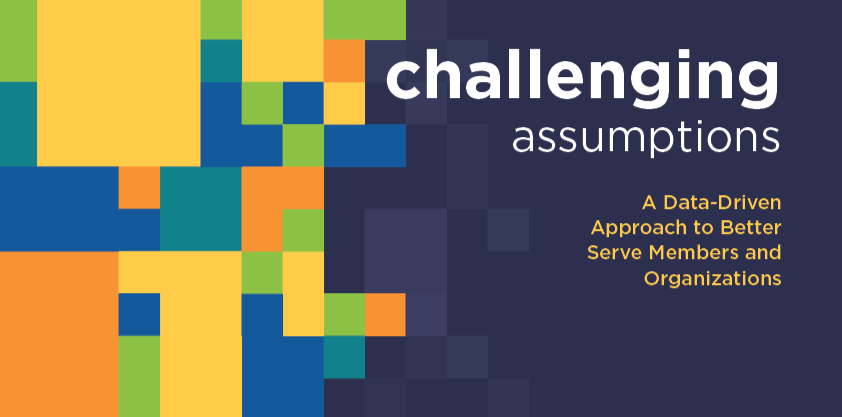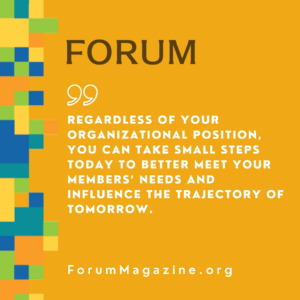Challenging Assumptions: A Data-Driven Approach to Better Serve Members and Organizations

As association professionals, we often assume what our members and prospects want or need from our organization—without asking them directly. These assumptions can stem from staff, volunteers or board leadership. They’re always well-intentioned but they can drive major organizational decisions that can cost thousands of dollars and countless hours of staff time, only to yield abysmal results.
So, how can we, as association professionals and leaders, challenge our assumptions to better serve our organizations and our members?
For Meagan Roloff, CAE, director of member services & engagement at the National Association for Gifted Children, the focus is on challenging assumptions. She emphasizes a data-driven and member-centric decision-making approach.
In both current and previous roles, Roloff has observed board members and other volunteer leaders confidently discussing what members want. These assumptions ranged from costs to project prioritization within the association’s overall workplan.
“I often find myself reminding folks that the moment they decide to volunteer—and especially once they become a board member—they are no longer a ‘typical’ member, even though they may still see themselves that way,” says Roloff. “They have a different level of investment in the organization.”
Challenging assumptions, especially from board members, isn’t easy. However, it is essential. Here are some steps that can help you get started.
Identify the Assumption and Its Importance.
The Illinois Academy of Family Physicians once believed that only those with years of practice experience and service to the organization were ready to join the board of directors. This assumption was challenged by staff and leadership.
“We could see that there was an energy and advocacy spirit among new-to-practice physicians who wanted to advocate and establish policy at the Academy level on a variety of patient care and medical issues,” says Ginnie Flynn, vice president of communications and member engagement.

For Roloff, it was more concrete. “I saw decline in member satisfaction coupled with a lack of engagement by newer members and members that came from backgrounds other than the dominant one in our association,” she said. “It was clear there was a growing disconnect between the association leadership and rank-and-file members.”
If once you identify your assumption and there is no direct impact on your organization, staff, or members, reconsider its importance. However, if your assumption is clear, and there is a definitive tie to your organization’s mission, vision, or strategic goals, progress to Step 2.
Gather your Data. Prepare to Be Wrong.
The best way to combat traditional or historical mindsights is with data. Assumptions are often made from anecdotal evidence. By gathering quantitative data to present to your decision-makers, you can move the conversation from subjective to objective, without making the challenge feel personal.
When I joined the American Board of Foot and Ankle Surgery in January, there was an assumption that our organization needed a Twitter presence. Drawing from more than 15 years in association communications, I also brought my own assumption that our members preferred fewer emails. So, we developed a three-question survey for an upcoming conference with participation from more than 200 students, residents, and practicing physicians.
When asked which social media platforms they used regularly, 66 percent of respondents cited Instagram, 45 percent cited Facebook, and 29 percent cited LinkedIn. Only 11 percent had a presence on Twitter. Assumption challenged.
We also asked how they wanted to receive communication from our organization, including email, text message, social media, website, direct mail, etc. An overwhelming 91 percent of survey respondents preferred to receive information via email. Assumption challenged.
To further challenge her organization’s assumptions, Roloff launched a member advisory group. The group was specifically set up to encourage members who might normally hesitate to volunteer. It was also designed to ensure that the full breadth of backgrounds and experiences within the association were represented (gender, race/ethnicity, age, experience, job role, job setting, students, geographic location, etc.).
“When we shared potential messaging, projects, etc., with the group, we always gathered the demographic data so we could segment our analysis. This was helpful in evaluating if a new proposal was resonating with its intended audience or if changes were needed,” Roloff says. “It was also key to opening the door for individuals from underrepresented backgrounds to engage with and feel ownership within the association.”
Feedback from the group provided an extra layer of context to board, committee, and staff decisions. In one example, the conference team tried to get more creative with swag items for an upcoming conference, so Roloff shared the options with the advisory group. “One item got a strong negative reaction from the advisory group because of some context within the profession,” she notes. “As staff, we never would have known and could have made a misstep.” Assumption challenged.
Take Action.
Data without action means nothing. If you have gone through the process of identifying your assumption’s importance and gathering data to help make your case, it’s time to create a plan. Consider goals, actionable items, and timelines. Recognize your limitations and set deadlines. Identify key stakeholders to take ownership of execution.
In response, the Illinois Academy of Family Physicians changed their bylaws, including adding two new physician members (defined as any physician who is within his/her first seven years of practice following completion of a family medicine residency) to the board, with staggered two-year terms and the right to vote. Then, they could continue with a three-year board term and feel confident running for executive positions after that. As a result, the organization’s past three presidents were 40 or under during their term and remain active in the Academy.
Staff and leadership have also developed resources for new physicians and parents. “These webinars and resources provide guidance and confidence to younger members so they can continue with their professional interests while growing their families,” adds Flynn.
Regardless of your organizational position, you can take small steps today to better meet your members’ needs and influence the trajectory of tomorrow.
“As staff, we are the best equipped to be the voice of the average member in the board room and in committee meetings. It is our responsibility to help volunteer leaders zoom out from their personal contexts and think in terms of the entire organization,” Roloff concludes. “Doing the extra work to take a data-driven approach is worth it if volunteer leaders are more confident and informed in their decisions. And who knows, along the way you may unearth some staff assumptions too!”
Tags
Related Articles
Building Tomorrow: HACIA’s Member Development Initiatives Are Reshaping the Construction Industry
Jacqueline Gomez, Executive Director of the Hispanic American Construction Industry Association (HACIA), describes the crucial...
Workforces at the Crossroads: Thriving Associations in a Changing Professional World
Unique pressures on professional workforces are changing the landscape for associations. Association leaders need precise...
Experience + Value = A New Formula for Successful Member Engagement
An interview with Amanda Lea Kaiser, author of “Elevating Engagement: Uncommon Strategies for Creating a...




